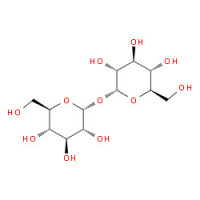
Nom de l'article:
Trehalose
Description:
Trehalose is a sugar consisting of two molecules of glucose. It is found extensively but not abundantly in nature, It is thought to be implicated in anhydrobiosis - the ability of plants and animals to withstand prolonged periods of desiccation. The sugar is thought to form a gel phase as cells dehydrate, and its molecular formula is C12H22O11.
Groupe:
Other Specialties
Numéro CAS:
99-20-7
Numéro EC:
202-739-6
Synonymes:
ergot sugar, a-D-, glucopyranose, O-a-D-glucopyranosyl, a-D-, glucopyranoside, a-D-glucopyranosyl.
Nom d’après UICPA:
(2R,3S,4S,5R,6R)-2-(hydroxymethyl)-6-[(2R,3R,4S,5S,6R)-3,4,5-trihydroxy-6-(hydroxymethyl)oxan-2-yl]oxyoxane-3,4,5-triol
Formule moléculaire:
C12H22O11
Masse moléculaire:
342.29 g/mol
Point d’ébullition:
675.4ºC at 760 mmHg
Point d’éclair:
362.3ºC
Point de fusion:
214-216ºC
Densité:
1.76 g/cm3
Code SH:
2940000000
Déclarations de risques:
R38
Fournisseur(s): 31

Univar Solutions GmbH
Germany
Trehalose
Expédition est disponible

UAB SynHet
Lithuania
Trehalose
Expédition est disponible

Shin-Etsu
United States of America
Trehalose
Expédition est disponible
Trehalose
Expédition est disponible

STOCKMEIER HOLDING GMBH
Germany
Trehalose
Expédition est disponible

STANLAB
Poland
Trehalose
Expédition est disponible

Radchem Products, Inc.
United States of America
Trehalose
Expédition est disponible

RT VANDERBILT HOLDING CO INC
United States of America
Trehalose
Expédition est disponible

QUIMIDROGA S.A.
Spain
Trehalose
Expédition est disponible
Trehalose
Expédition est disponible

OQEMA
Germany
Trehalose
Expédition est disponible
Trehalose
Expédition est disponible

Nanjing Lanya Chemical
China
Trehalose
Expédition est disponible

Molekula
Germany
Trehalose
Expédition est disponible
Trehalose
Expédition est disponible

Matrix Fine Chemicals GmbH
Switzerland
Trehalose
Expédition est disponible

MT Chemtech
Japan
Trehalose
Expédition est disponible
Trehalose
Expédition est disponible

Julius Hoesch GmbH & Co. KG
Germany
Trehalose
Expédition est disponible

Intrachem Limited
Ireland
Trehalose
Expédition est disponible
Trehalose
Expédition est disponible

HARKE Chemicals GmbH
Germany
Trehalose
Expédition est disponible
Trehalose
Expédition est disponible

Chemicals United B.V.
Netherlands, Kingdom of the
Trehalose
Expédition est disponible
Trehalose
Expédition est disponible

Brenntag GmbH
Germany
Trehalose
Expédition est disponible

Bazayan & Co
India
Trehalose
Expédition est disponible

BCD Chemie GmbH
Germany
Trehalose
Expédition est disponible

Apollo Scientific LTD
United Kingdom
Trehalose
Expédition est disponible

ALTEQO
Netherlands, Kingdom of the
Trehalose
Expédition est disponible

ALL Chemistry Inc.
United States of America
Trehalose
Expédition est disponible
